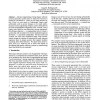392 search results - page 12 / 79 » Reversal Complexity Revisited |
DAC
2010
ACM
13 years 11 months ago
2010
ACM
Reversible logic became a promising alternative to traditional circuits because of its applications e.g. in low-power design and quantum computation. As a result, design of revers...
ICSE
1995
IEEE-ACM
13 years 11 months ago
1995
IEEE-ACM
— Reverse engineering of large legacy software systems generally cannot meet its objectives because it cannot be cost-effective. There are two main reasons for this. First, it is...
CORR
2010
Springer
13 years 2 months ago
2010
Springer
Combinational or Classical logic circuits dissipate heat for every bit of information that is lost. Information is lost when the input vector cannot be recovered from its correspon...
JLP
2010
13 years 6 months ago
2010
Various simplified or improved, and partly corrected well-known implicit characterizations of the complexity classes FPTIME and NC are presented. Primarily, the interest is in si...
ENGL
2008
13 years 7 months ago
2008
Reverse engineering has become a viable technique to create a 3D virtual model of an existing physical object. It enables the reconstruction of body surfaces to create a suitable C...

